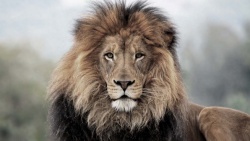The Lion-A Symbol of Power
Almost every country uses certain Animals to symbolize one thing or another. Americans, for instance, use the eagle to symbolize freedom and strength.In China, several Animals have been given symbolic meaning. The mythical dragon was used by emperors to represent their supreme authority, the crane stands for longevity, mandarin ducks for Love and loyalty, and the crow for bad luck.
What does The lion stand for, though? In China, The lion is regarded as the king of the forests and of the other Animals. It has thus long been used as a Symbol of Power and grandeur. It is even believed to offer protection from Evil spirits. That’s why imposing Statues of lions were placed at the gates of imperial palaces, official residences, temples and tombs. Incense burners and imperial seals were also often decorated with carved lions. Indeed,like images of the dragon,carved lions can be seen almost everywhere in China. The most famous carved lions are the pair that guard Tian’ anmen, the main entrance of the Forbidden City. Several meters tall, these marble lions have been poised imposingly on the stone plinths for more than 500 years. Visitors to Beijing often like to have their pictures taken with these famous landmarks.
Lions can also been found In Tibet’s Potala Palace,though the Tibetan lions differ somewhat from those in other parts of China. The biggest lion,however,is an iron one at Cangzhou in Hebei Province. Cast in the 10th century, it stands more than five meters high and weighs 49 tons. Chinese lions do not just guard gates.Bridges often feature lion sculptures, by the Way.The balustrades of the 17-arch bridge at the Summer Palace in Beijing, for instance, are topped with 120 marble lions, no two of them exactly alike.Sone are menacing, others seem to be peering into the lake. Females have frisky cubs lying on their backs or peeking out from their embrace. The bridge most famous for its lions, however,is the Lugou Bridge,southwest of Beijing. Built in the 12th century , this imposing bridge is 266.5 meters long and 7.5 meters wide and stands on 11 arches. Westerners call it the Marco Polo Bridge, because the 13th century Italian traveler,Marco Polo,crossed it and wrote a vivid description of it in his Travels. On the top of each balustrade post is atleast one stone lion.
Many of the bigger ones have small ones on their backs or under their bellies. The smallest is no bigger than a mouse.They vary in Posture: some are squatting, others standing; some lie face downwards, others face up;some glare with round Eyes and stick out their tongues,while others weem to laugh with narrow Eyes as they gaily romp after each other. How many lions are there altogether? In the past ,the lions were said to be uncountable, because so many small ones are hidden beneath the bellies and paws of the bigger ones and it ones are hidden beneath the bellies and paws of the bigger ones and it was very easy to overlook a few. But today we know that there are 485 in all. The styles of the lions changed over Time. The 1,400-year-old tombs of the Liang Dynasty outside Nanjing are famous for their winged lions. Two lions three meters high strut proudly forward, head high and chest out.
In the Tang Dynasty, which ruled between 618 and 907, seated lions were frequently used They rest on heavy legs so solid that they seem rooted to the Earth Their style mirrors the strength of the Tang Dynasty itself and they are considered sculptural masterpieces. Lions of the Song Dynasty,from the 10th to 13th centuries, had curling manes, More true to Life than their predecessors, their features were copied by the stone masons of the Ming Dynasty which followed. In the Qing Dynasty, stone lions were placed in temples and Gardens In this period Chinese sculpture was far more lively.
Some lions hold a ball in their forepaws,others roar.Are you frightened? Well,in folk dances,this cruel and powerful beast has been tamed into a playful, even mischievous character. Wearing bells, he runs after a colorful ball, which bounces to the rhythm of the drums. He cavorts about, chases a ball up and down a swaying seesaw, scratches himself, lies down and pants or even drops off for 40 winks of Sleep.
